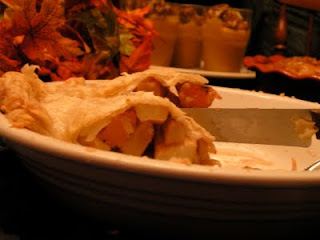
Christmas Pudding. Here I start with two cups of raisins soaked in brandy, some shredded carrots and breadcrumbs (from a cranberry-sunflower loaf, to be exact). I followed that recipe but added four ground cloves and used candied lemon, orange and quince. Greased the pan bith butter but used suet as the fat for the pudding.

Here it is, a full recipe's worth in a 1.2L pudding tin.

Cover with wax paper, steam in a covered pot, partially filled with water, for 4½ hours at 450ºF.

Age for a few days, weeks, months. (This aged 2 weeks). Cover, re-steam for an hour.

Serve with hard sauce (butter, sugar, brandy).

Chilled hard sauce.

Finish with flaming brandy. This is my new favorite dessert. Moist, rich with flavor, and served with hard sauce, it is perfect.













































